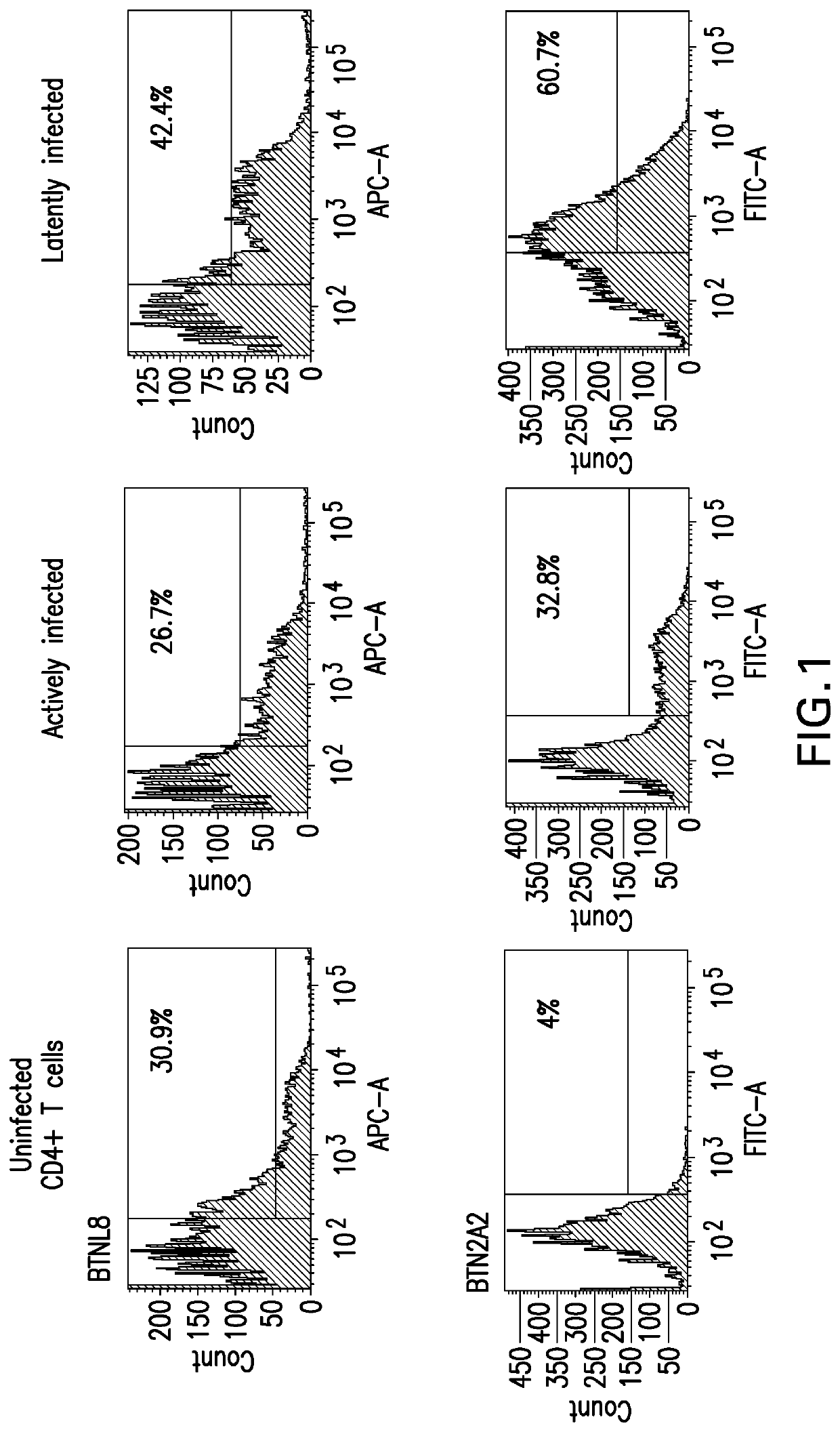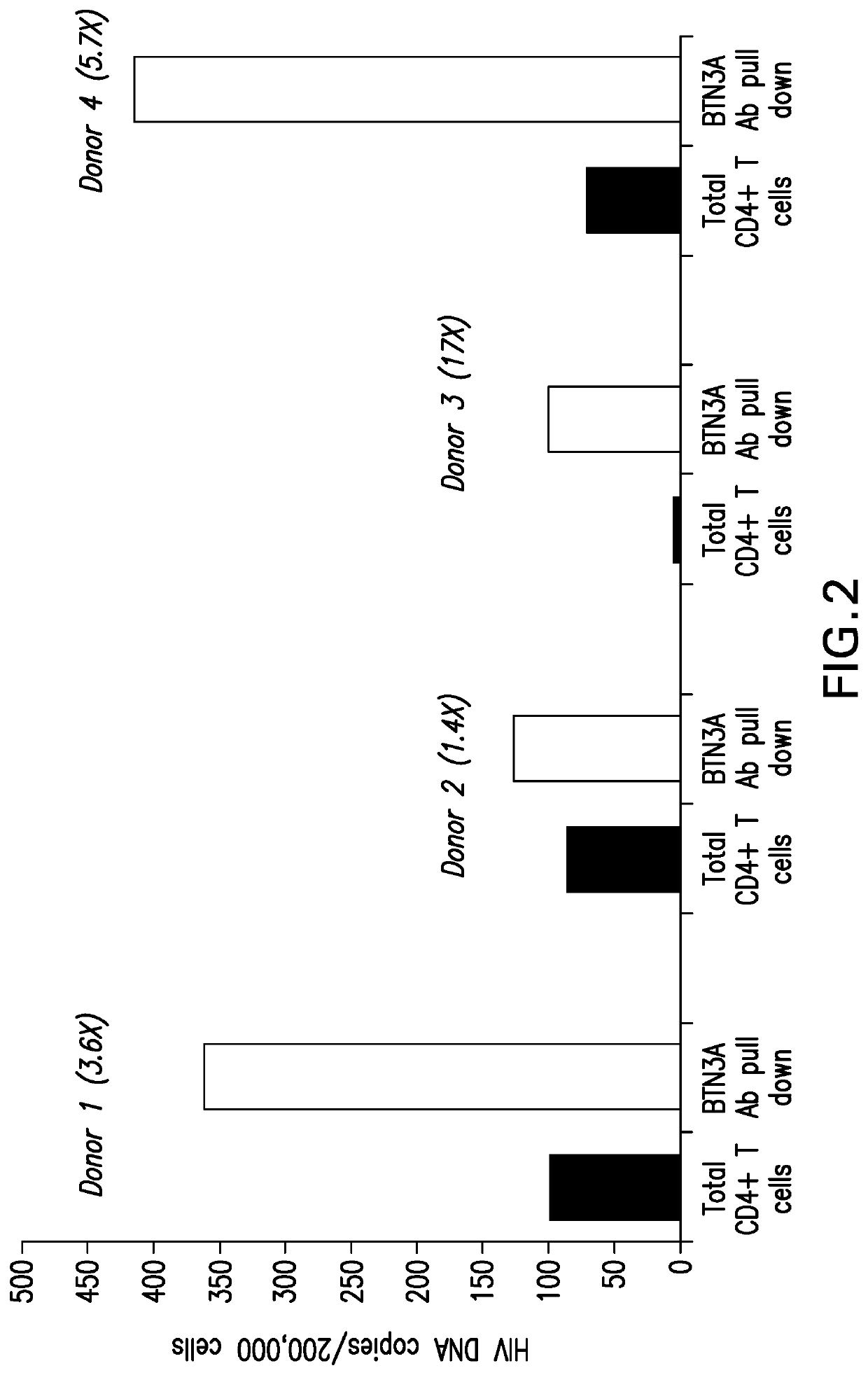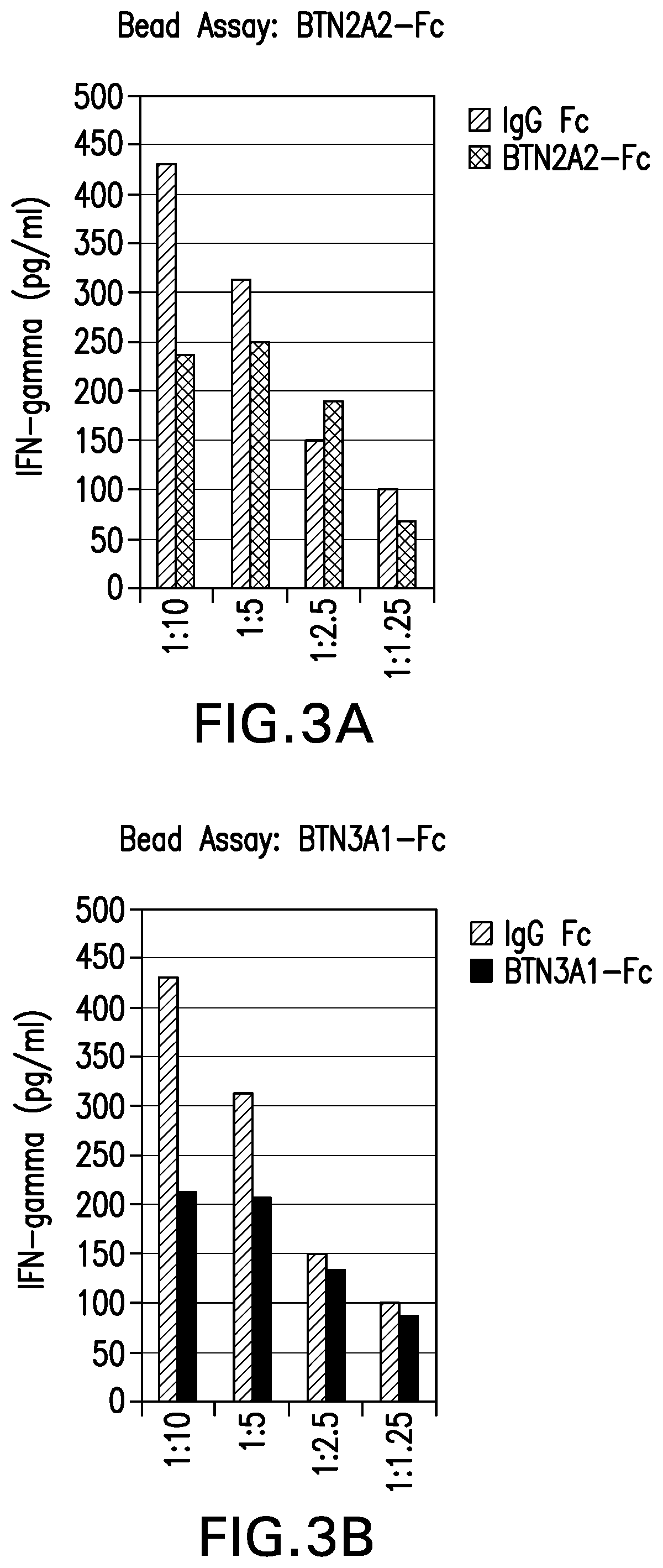Methods of using butyrophilin antibodies for treating HIV infection
a technology of butyrophilin and antibody, applied in the field of methods, to achieve the effect of increasing the ability of antibody or antigen-binding fragment, and reducing the number of antibodies
- Summary
- Abstract
- Description
- Claims
- Application Information
AI Technical Summary
Benefits of technology
Problems solved by technology
Method used
Image
Examples
example 1
ation of Novel Biomarkers / Targets of HIV Latency Using Aptamer Screens
A. CD4+ T Cell Model of HIV Latency / Production of Latent HIV-1-Infected Primary Cells:
[0116]Latent HIV-1 infected primary CD4+ T cells were generated following a protocol licensed from the laboratory of Jonathan Karn (Case Western Reserve University, Cleveland, Ohio) [2]. Briefly, naive CD4+ T cells isolated from 2 healthy human donors were propagated for 6 days in growth medium supplemented with Dynabeads Human T-Activator CD3 / CD28 (25 μl / 106 cells) and Th17 polarizing cytokines: TGF-β1 (5 ng / ml), IL-4 (10 ng / ml), IFNγ (10 ng / ml), IL-1β (10 ng / ml), IL-6 (30 ng / ml), IL-23 (50 ng / ml), IL-8 (15 ng / ml), IL-10 (10 ng / ml). Th17 polarized cells were subsequently infected with a VSV-G-pseudotyped HIV-1 Nef+ virus that expresses mouse CD8a and d2EGFP. HIV-1-infected cells were then purified with a mouse anti-CD8a selection kit and quiescence was induced in the infected cells by culturing in growth media containing low con...
example 2
BTN Modulation on T Cell Activation
A. Inhibition of T Cell Responses by Human Butyrophilins:
[0127]To characterize the role of butyrophilins in regulating T cell responses, T cell assays were performed using recombinant human butyrophilin-Fc proteins. Specifically, we assessed the role of butyrophilins in inhibiting T cell receptor (TCR)-mediated T cell activation by anti-CD3 antibody (clone OKT3). Experiments were performed in bead- and plate-based formats.
i. Bead-Based Assay:
[0128]Briefly, PBMCs were isolated from healthy human donors (Biological Specialty Corporation, Colmar, Pa.). To generate T cell blasts, PBMCs were treated with IL-2 (4u / ml) and PHA (1 μg / ml) in RPMI media containing 10% Fetal bovine serum (Gibco, Gaithersburg, Md.), penicillin (100U / ml) / streptomycin (0.1 mg / ml) (Gibco, Gaithersburg, Md.), and L-Glutamine (2 mM) (Gibco, Gaithersburg, Md.) at 37° C. in a CO2 incubator for 7 days. Fresh media was added once every 3 days.
[0129]Total CD4+ T cell populations were pu...
example 3
BTN Modulation on HIV Latency
[0138]A. HIV Latency Reversal Resulting from BTN Modulation
[0139]To assess if BTN3A modulation has impact on HIV latency reversal, sterile 96-well flat bottom tissue culture plates (Corning) were coated with various concentrations of anti-CD3 and anti-BTN3 20.1 antibodies (10 μg / ml, 3 μg / ml, 1 μg / ml, and 0.3 μg / ml) in PBS for 16h in a 4° C. refrigerator. As controls, plates were coated with various concentrations of anti-CD3 antibody and isotype control antibody (10 μg / ml, 3 μg / ml, 1 μg / ml, and 0.3 μg / ml), anti-CD3 antibody alone, or isotype control antibody alone. The next day, antibodies were aspirated using a multichannel pipette and HIV latent primary CD4+ T cells from two donors were added to the antibody coated plates in duplicates at 125,000 cells / well in 200 ul of primary cell media (RPMI with 10% FBS, 50 μg / ml Primocin™). At 24 h post treatment latent virus reactivation was measured using a Nano-Glo® Luciferase Assay (Promega) (FIG. 5).
[0140]Tre...
PUM
| Property | Measurement | Unit |
|---|---|---|
| Cell proliferation rate | aaaaa | aaaaa |
Abstract
Description
Claims
Application Information
 Login to View More
Login to View More - R&D
- Intellectual Property
- Life Sciences
- Materials
- Tech Scout
- Unparalleled Data Quality
- Higher Quality Content
- 60% Fewer Hallucinations
Browse by: Latest US Patents, China's latest patents, Technical Efficacy Thesaurus, Application Domain, Technology Topic, Popular Technical Reports.
© 2025 PatSnap. All rights reserved.Legal|Privacy policy|Modern Slavery Act Transparency Statement|Sitemap|About US| Contact US: help@patsnap.com



